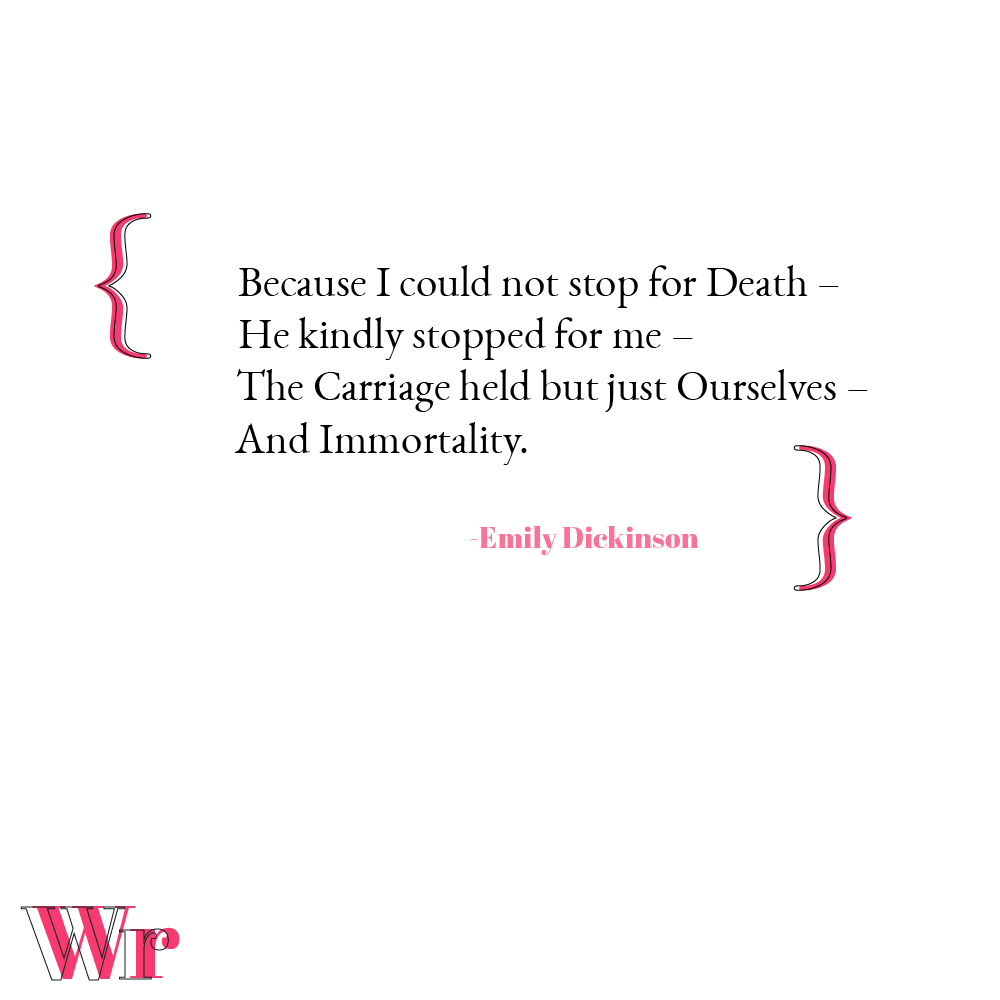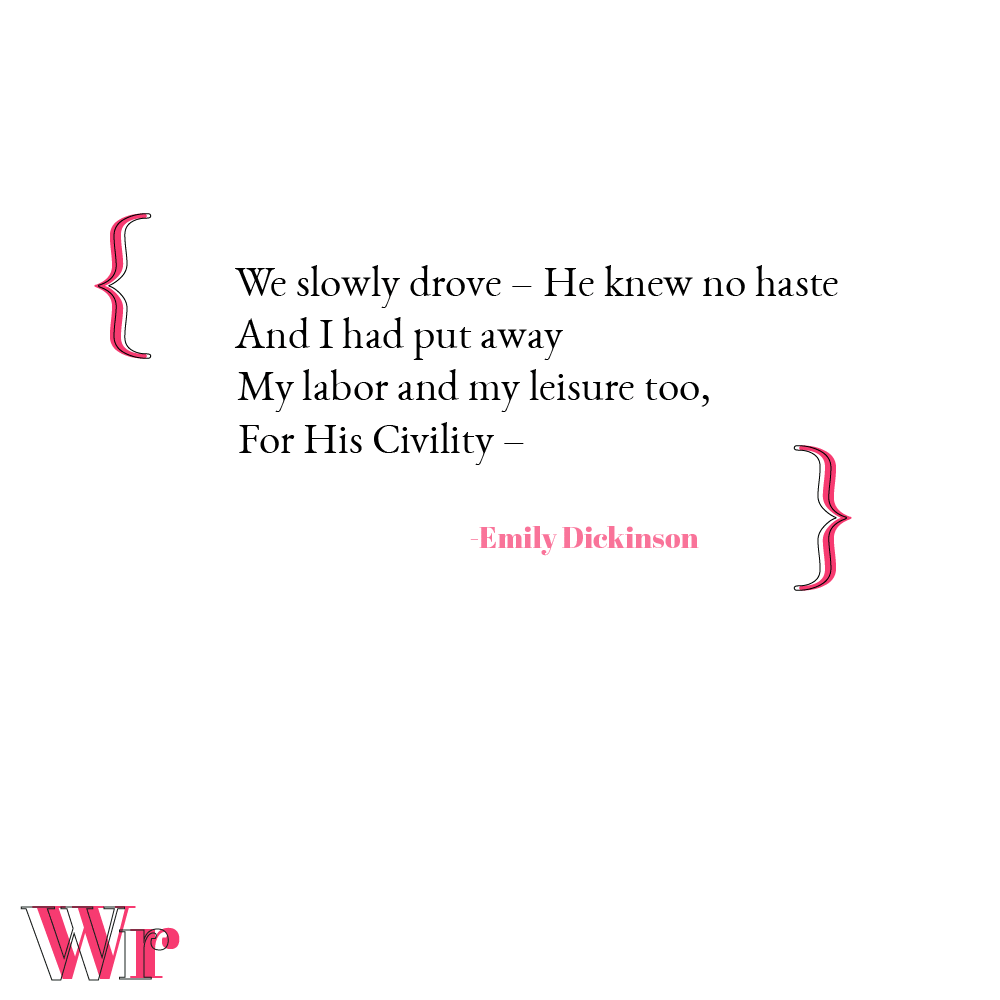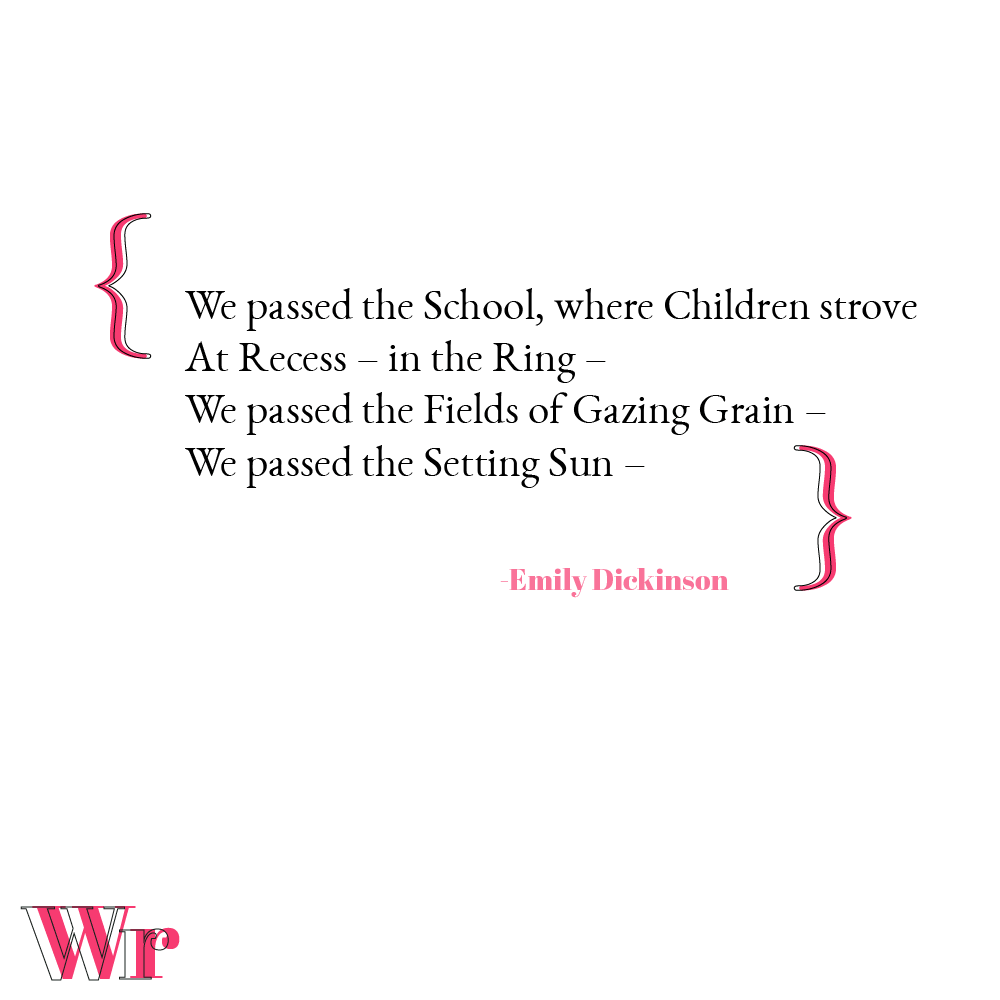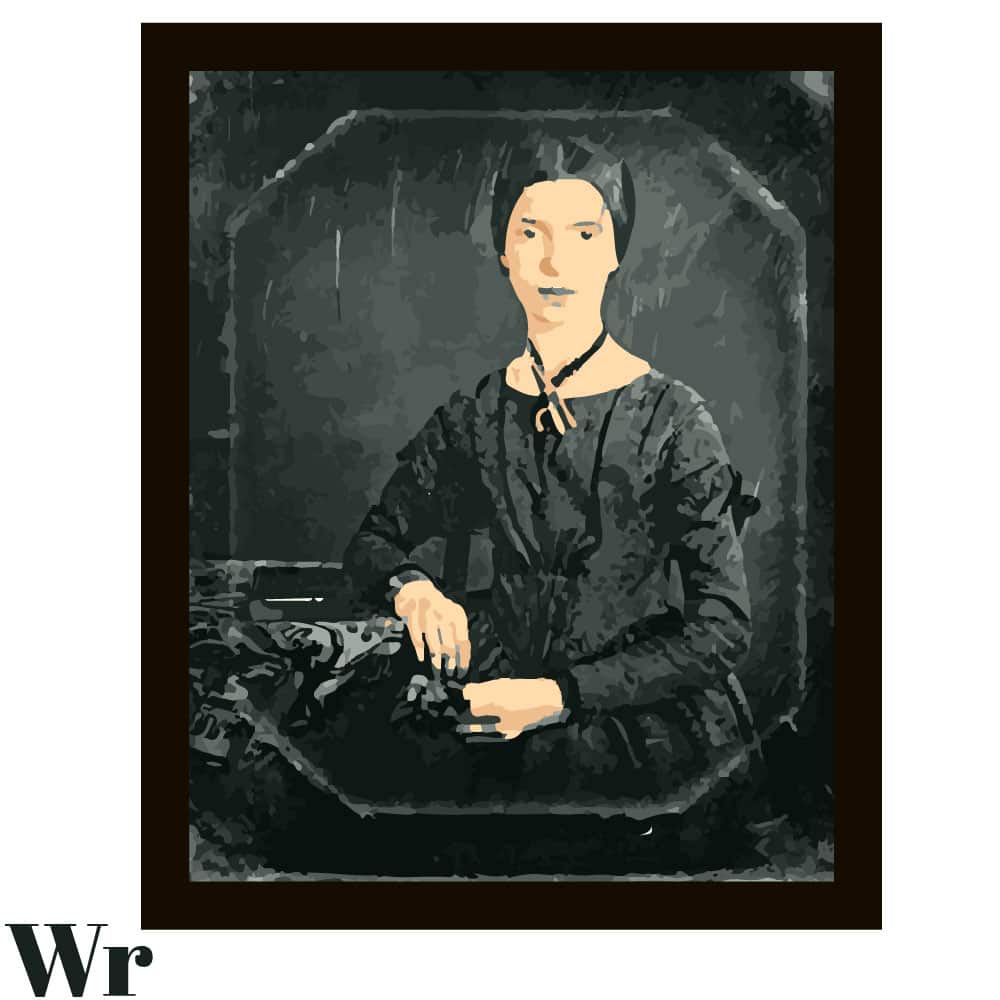The concept of death and life after that has been a muse of many creative pieces, ranging from paintings, essays, stories, and poems. The poem Because I could not stop for death by Emily Dickinson is about death’s approach, its convincing persona, and the irony of immortality. To understand what more is hidden in this gem of a poem, here’s Because I could not stop for Death analysis.
We’ll begin the analysis by looking at the poem, stanza by stanza, analyzing each while drawing parallel with the life of Dickinson and the influences that led to the creation of the poem.
The latter part of the article will have the meaning, summary, structure, and philosophical implication and interpretation of the poem, along with the literary devices used.
Because I could not stop for Death –
He kindly stopped for me –
The Carriage held but just Ourselves –
And Immortality.
We slowly drove – He knew no haste
And I had put away
My labor and my leisure too,
For His Civility –
We passed the School, where Children strove
At Recess – in the Ring –
We passed the Fields of Gazing Grain –
We passed the Setting Sun –
Or rather – He passed Us –
The Dews drew quivering and Chill –
For only Gossamer, my Gown –
My Tippet – only Tulle –
We paused before a House that seemed
A Swelling of the Ground –
The Roof was scarcely visible –
The Cornice – in the Ground –
Since then – ’tis Centuries – and yet
Feels shorter than the Day
I first surmised the Horses’ Heads
Were toward Eternity –
Poem used for explanation and reference, under fair use. Copyrights go to Emily Dickinson.
Because I could not stop for death analysis
Before diving deep into the finer details and meaning of the poem, it is imperative to give the overall theme of the poem.
Dickinson talks about the approach of death, the time and journey of passing from one world to another, and finally, becoming immortal.

Death arrives
Because I could not stop for Death –
He kindly stopped for me –
The Carriage held but just Ourselves –
And Immortality.
Line 1 and 2
The very first line starts with a “because” which makes the line as a form of explanation. It is as if Dickinson is solving a quandary of someone. It holds as the poem is about life after death.
Stopping for death means dying. Emily could not stop for death, and most people cannot as well. No one wants to die, no one wants to meet death. But death stops for everyone. It could be kind, or it could be gruesome.
Here, kindly means that the death that comes to Emily is a kind and gentle one, like someone passing away peacefully in their sleep. There is no pain involved.
Line 3 and 4
The carriage here can be interpreted as the coffin, which is the last carriage someone boards. Not just in Christianity, most of the culture has some sort of “carriage”. It is the fourth line that gets misunderstood.
There is just death and the person for whom death stopped. There is no immortality. Rather, when someone with a fading life gets in this carriage with death, their conflation creates immortality. Immortality is the consequence of this moiety. The narrator is on the path or process of becoming immortal.

The journey
We slowly drove – He knew no haste
And I had put away
My labor and my leisure too,
For His Civility –
From what we have learned from the previous stanza, death is not a ravaging ghoulish consumer of life, but a very calm, gentleman-like person. The second stanza enforces this view even further.
Line 1 and 2
The whole ordeal of death’s stopping and getting into the carriage was slow and calm. They drove slowly, there was no rush. This could be compared to the calm release of death which people feel, the peace of passing away.
Lines 3 and 4
This is the reciprocal behavior shown by the narrator. The narrator gave up all her labor and leisure in return for the civility shown by death. This means because death was painless and calm, she gave up all her life’s attachments.
Labor and leisure represent the joys and struggles of life. This is what people hold on to in their last moments. Remembering the happiness life gave them. They even remember the difficult times.

The transition
We passed the School, where Children strove
At Recess – in the Ring –
We passed the Fields of Gazing Grain –
We passed the Setting Sun –
Let’s divide this stanza into three sections, or three lines instead of four. The first is about school children and their merry time filled with childish struggles. This represents the childhood of a person, the first phase of life.
We passed the Fields of Gazing Grain – This line represents the youth, the period of fertility. The grains have reached the point when they are useful. This is similar to how people are most useful (in the sense of productiveness) in their youth.
Finally, we come to the last line of this stanza, passing the setting sun. What could a setting sun represent? The end of the day, the end of one’s life. When the eyes close and the darkness takes the place of light. The transition has been completed.
I feel this stanza is about a smaller journey someone takes before their life ends. It is sort of playback of everything worth remembering, the last smile that is brought by memories that made life worth living.

Realization
Or rather – He passed us –
The Dews drew quivering and chill –
For only Gossamer, my Gown –
My Tippet – only Tulle –
The sun has set, the cold has set in and the narrator is hit with what’s happening. There is no heaven, there is no light. There is just mournful immortality that will last for eternity. This is a cruel irony.
Lines 1 and 2
The first line of this stanza starts with the realization that something is not how it seems. The carriage was not going past the sun, or the school or the fields. They were stuck in time while everyone else moved. Everyone else was alive, going ahead in it. The narrator ceased to exist, watched them pass by.
This observation is followed by a sensation. The dews started making the narrator quiver. There was a chill. Now we start seeing death take its idiosyncratic form. Darkness, lack of warmth, quivering, all are companions of death.
Lines 3 and 4
These two lines have a latent metaphor, very subtle yet very important. The narrator says that when she felt the shiver of cold, she realized that she only had a gown of gossamer. Gossamer is a very thin, flimsy, silk-like fabric. She also had a scarf (tippet) that was made of tulle which is very similar to gossamer. Now, what does this imply, metaphorically?
This shows the objective truth of death. We never take with us our possessions after death. All the narrator had was a thin, flimsy fabric for covering. There was no gold, silver, trinkets, or the much-desired money. Just fabric to cover the body.

A new home
We paused before a House that seemed
A Swelling of the Ground –
The Roof was scarcely visible –
The Cornice – in the Ground –
After the realization was over, the narrator’s journey ends for a new journey to begin. She reaches her new home; her grave. Dickinson’s brilliance can be seen here in the description of the grave as a house.
The house seemed like swelling of the ground. This is a grave that has been filled. This is where her body resides. No roof could be seen and the cornice was in the ground. The cornice is a decorative molding (or structure) that is right below the ceiling.
This grave was her new home. This is where she would have to stay. She will be inside the earth.

Immortality
Since then – ’tis Centuries – and yet
Feels shorter than the Day
I first surmised the Horses’ Heads
Were toward Eternity –
She has finally become immortal. She is now dead. In the end, we come to know that she was remembering what had happened centuries before when she died. Now she resides in her house. She will reside in this house for eternity.
That day when she got into the carriage with death, that day feels longer than the centuries that have passed. That day was the day she tasted immortality.
The reason why she feels that the day feels like it lasted more than centuries is because that was the day she died. That was the day time ceased for her and she became an eternal memory. In a sense, she lived her entire life in that carriage.
The last two lines also reveal something about that journey. That day was the day when she guessed that the carriage was moving towards eternity. And eternity also has another face; immortality.
Read more poems by Emily Dickinson
- Wild Nights! by Emily Dickinson: How this poem took guts to write
- Color-Caste-Denomination- What we need to learn about equality and discrimination
- Fame is a Fickle Food: All the shines is not gold, but something dangerous
- Tell the Truth but Tell it Slant: When the truth is not what people deserve
Immortality and the irony
The irony of this immortality is that people get it after they die. So seeking immortality does not mean eternal life, it just means life after death. The narrator has become immortal, living in her grave for eternity. But the price for that was her life.
Immortality here has other implications as well. No one can live forever. Yet we associate immortality with eternal life, which is oxymoronic. But this doesn’t mean that immortality is unachievable.
One becomes immortal in memories. Think of the people who died millennia ago, yet we know of them and their works. Take a look at Emily Dickinson as well, long in her eternal life, yet we are learning about her thoughts.
This poem was once in her thoughts. Is she not speaking to you and me at this moment, albeit not from her voice, but these were her words. This is what immortality means; living in memories, and her grave.
Literary devices in the poem
Here are all the literary devices used in “Because I could not stop for death”;
Metaphor – Dickinson has always put a lot of focus on the metaphors in her poems. This entire poem can be used as an example of a metaphor. It would be pointless to mention the metaphors here because the entire poem is a metaphor. Each stanza is a metaphor that relates the death, the life after death.
Alliteration – The examples of alliteration used are;
- My labor and my leisure too
- At Recess – in the Ring,
- Gazing Grain and Setting Sun
- Gossamer, my gown
- My Tippet – only Tulle –
- Horses’ head
Anaphora – anaphora is the repetition of words or sentences at the beginning of consecutive lines. This is used to emphasize the lines, showing the importance of that process. Here, the lines having anaphora is;
We passed the School, where Children strove
At Recess – in the Ring –
We passed the Fields of Gazing Grain –
We passed the Setting Sun –
Personification – It is the representation of some inanimate thing or a concept as a living, breathing human. Here, death has been personified and represented as a civil gentleman.
Structure of the poem
The poem’s rhyming structure is a unique and bizarre one. But this is expected of Dickinson as most of her poems stand out because of the unique structure they possess. While some words don’t rhyme exactly, they have very similar sounds, and hence, this is called half-rhyme or slant rhyme. Here’s the rhyming scheme;
ABAB | ABCB | ABCD | ABCB | ABCB | ABAB
I know readers might be confused by seeing these patterns as some words are way off in the pronunciation. The explanation for this is the words are spoken in a way that rhymes with the other similar word.
In the second stanza, the word “away” and “civility” might not sound very similar, but if you say “civility” as ci-vi-li-tay, then the rhyme emerges. The same goes for the last stanza’s rhyming scheme.
The third stanza has no rhyming pattern and it is understandable. The poem aimed to focus on the events being described and not the tone or sound of the poem. This disruption and loss in the rhyming scheme turn this stanza as a narrative, necessary to explain the crucial journey. It also adds to the appeal of the poem as too much rhyming can often take away the seriousness of the poem, causing “rhyme fatigue”.
The last stanza has the words “chill” and “tulle” as the rhyming words. The pronunciation of “tulle” is “tool”, but here we are looking at the “l” sound of the word. Hence, the ABCB scheme emerges.
This concludes the analysis of Because I could not stop for Death by Emily Dickinson. In summary, the poem is a narration of what it feels to die and how the irony of immortality is letting go of your life, living in the graves forever. To be immortal, one must let go of time.
